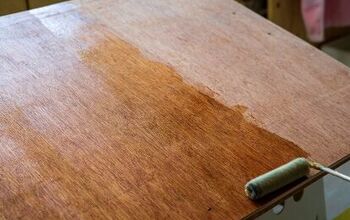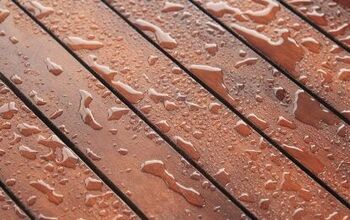Can You Stain Over Danish Oil?

There are few things that are quite as nice as seeing an antique wood furniture piece that has added shine thanks to Danish oil. It also happens to be one of the only types of stains to have a certain level of food prep quality to it. But, what if you don’t want to have that light oil finish? Can you stain over Danish oil?
You can use a gel stain over a Danish oil finish. Traditional water and oil-based stains can’t be used over Danish oil. You can also add an oil-based stain to the Danish oil before it’s applied or apply the stain first.
Danish oil is notoriously good as a wood protectant. That’s a good thing…until you actually want to stain over it. We’re going to uncover what we were able to find out about this stuff so you can make the right choice for you.
Do You Need to Hire a Paint Contractor?
Get free, zero-commitment quotes from pro contractors near you.

Why Is Danish Oil So Hard To Stain Over?
So, Danish oil is a specialty finishing oil meant to protect wood and add shine to it. It’s also a stain that is notorious for being rather difficult when it comes to having anything penetrate it. That’s why it is often used to cover cooking utensils like wooden spoons and cutting boards.
Danish oil has a way of being a miraculously good pore filler. Stain needs to soak in via the pores of the wood for it to work. So, you won’t actually have enough porosity in your wood for the stain to soak in properly. As a result, most stains will not take to a wood item treated with Danish oil.
How Do You Add Stain To Danish Oil?
This is fairly easy to do. Here’s how:
- Figure out how much Danish oil you have and buy the appropriate amount of stain. Most people will be able to add around 5 to 10 percent of the volume of the Danish oil, max. This will give you a light touch of color without actually impacting the quality of the oil. So, 5 milliliters of oil per 100 milliliters of oil will be enough.
- Measure out 5 to 10 percent of the oil’s volume in stain, and pour it in. Make sure you add oil-based stain, not water-based.
- Gently stir until it is totally absorbed into the Danish oil. You now have Danish oil that’s ready to use immediately.
Is It Better To Get Pre-Tinted Danish Oil?
If it is possible at all, try to get a can of Danish oil that is premixed and pre-tinted. This prevents you from having to worry about mixing it in and can also ensure a better quality of finish.
What Kind Of Stain Works For Use Over Danish Oil?
Neither oil-based stain or water-based stain will work with Danish oil. This is because traditional stains require pores in wood if you want to make sure it gets absorbed. You need to use gel stain.
How To Apply Stain Over Danish Oil
Here’s what you need to do to use stain over Danish oil:
- Go to the store and get a canister of gel wood stain. Gel stains are the only ones that don’t require any porosity of material.
- Clean the wood. Wipe it down with a wet towel and dry it off with a microfiber rag.
- Grab a paint brush and apply the gel stain to the wood. Be careful when applying it, as you have to make sure that the layers are as streak-free as possible. The best way to make sure you do it well is to apply it per the directions on the can.
- Add a second layer, if needed. Be forewarned, you need to wait a couple of hours for the stain to dry. A second layer can also make the stain look streaky. If you can’t risk that, you might need to skip a second or third stain.
Note: You also might be able to get the stain to work by buffing away the oil with a high grit sandpaper. This will allow the stain to penetrate. Then, you can re-add the Danish oil if you choose.
What Finish Can Be Applied Over Danish Oil?
Danish oil is a finish, but you can add another coat of a different finish if you want to. Both lacquer and polyurethane can be applied over Danish oil as a final finish. Just make sure the oil is dried first.
How Long Does Danish Oil Take To Fully Cure?
Danish oil will be dry to the touch within six to eight hours of application. If you want to add a finish to it, it’s best to wait 24 to 72 hours for the full curing process to complete. You can find out the specific curing time for your Danish oil on your can. Most take 48 hours.
Does Danish Oil Darken Over Time?
While Danish oil will darken the wood it’s applied to mildly as it soaks in, it will not continue to darken as time progresses. Part of the beauty of Danish oil is knowing that it’ll continue to look the same as years pass.
A Very Important Final Note About Stain And Danish Oil
Even if you want to make a college try of staining over Danish oil, your results are not guaranteed to look very well. Danish oil finish is very difficult to work with. If you want to get both a stain and a Danish oil on your woodwork, do whatever you can to put the stain on the wood before you add Danish oil.
Truth be told, Danish oil is something that really needs to be treated like a final finish. Unless you are okay with a streaky finish, you will avoid trying to do this. It’s risky, even if you are a fairly skilled woodworker. With that said, sometimes a streaked look can be good. So, it’s up to you.
Do You Need to Hire a Paint Contractor?
Get free, zero-commitment quotes from pro contractors near you.

Related Questions
Which is better, Danish oil or linseed oil?
Both oils offer a beautiful finish for wood, but it’s clear that one tends to be a bit better for most purposes. Danish oil tends to be more resilient than regular linseed oil. It also is faster-drying. The only issue is that Danish oil tends to have a glossier look, while linseed tends to seep into the wood for a more velvety, satin finish. It’s up to you to pick the one for you.
What is the difference between Danish oil and stain?
Danish oil is a deeper-penetrating finish that has a very light tint and is meant to be food-safe. Stain may or may not be food-safe, and only penetrates the first couple of layers. Unlike Danish oil, stain can be a wide range of different colors and also tends to be very versatile. Danish oil tends to give wood a very well-rubbed, artisan look and also remains more resilient.
Do you have to seal wood that is coated with Danish oil?
One of the best things about using Danish oil is that you don’t have to worry about sealing it. This oil finish works as its own sealer. However, you always have that option if you want to. If you want to finish up a wood piece with a sealant, an oil-based varnish-like resin will do the trick. Just make sure your varnish is graded food-safe if you’re making a cutting board.

Ossiana Tepfenhart is an expert writer, focusing on interior design and general home tips. Writing is her life, and it's what she does best. Her interests include art and real estate investments.
More by Ossiana Tepfenhart



























